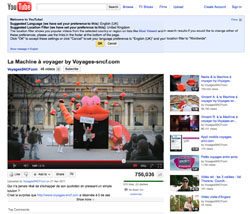“Effectiveness” conjures up images of getting things done in a rational, logical, by-the-book sort of way. It’s how Western society is structured. But with the world around us changing as quickly and palpably as the weather, it’s time to readjust. Logic is an important tool. But it’s not the only one in the box.
Let's start by using our brain
The world doesn’t work in straight lines and neat patterns, so relying on old logic-based models to survive the recession and beyond is, thinking logically, downright illogical. But it’s not about discarding logic in order to blindly follow our heart. It’s about understanding the value of both sides of our brain and using them together.
What people want
The first step is to look at what people want. And that’s quality, value for money and choice. But it doesn’t stop there. Consumers also want an emotional experience–excitement, entertainment, reassurance, user-friendliness. And it’s got to be personalized, relevant to their hectic lifestyles and eco-friendly too. Oh and they want it yesterday. Listed in this way, it feels like an impossible mountain to climb. But Henry Ford’s insight, “If you always do what you’ve always done, you’ll always get what you’ve always got”, should provide some sense of direction. By committing to doing things differently, supported by the “feeling” nature of our right-brains, we open the doors of possibility.
Softer, better, faster, stronger
Nick Jankel, a public intellectual, social innovation expert and transformational coach in the
David Brooks, author of The Social Animal: The Hidden Sources of Love, Character and Achievement believes that success (and happiness) depend on understanding “the inner mind–the unconscious realm of emotions, intuitions, biases, longings, genetic predispositions, character traits and social norms”. He believes that emotions are the foundation of our reason because it’s our emotions that tell us what to value. His argument is that the world’s rule-makers have for too long dismissed “the unconscious” as an obstacle on the path to ‘wise’ decisions. This has helped separate our reason from our emotion, and resulted in a shallow view of human nature. As such, material accomplishments have taken precedent over the social and emotional development it all depends on.
His book suggests that we are not contained, rational animals, but social animals whose drive and potential to succeed can be met by honoring the unconscious mind’s hunger to be lost in a challenge or a task, and to feel at one and in the moment. This last point can be summed up in one word: flow.
Let it flow
For Jeremy, being able to get inside a problem is the key to effectiveness. “Creatives have to sit and work things out, and that’s a solo activity. I think most people grossly underestimate how hard it is to work collaboratively.” Avoiding distractions is also key. “There’s a lot of pseudo urgency around that isn’t actually urgency at all. It’s the technology that allows us to be urgent. You have to learn to shut things out and remind yourself that you know who you are, you know how you work well, and then just create that environment for yourself.”

Taking fun seriously-in communities

SNCF’s Escape Machine rewards the curious button-pusher with a ticket to their destination of choice.

The Saucy Fish brand has reinvigorated the
Taking fun seriously-on shelves
.jpg)
This
Investing in creativity
By leveraging our creative and innovation sectors, and by championing and rewarding creative thinking early on in schools, we can encourage new generations of creative thinkers: people who get things done, but who get things done using all of their mental and emotional resources.
